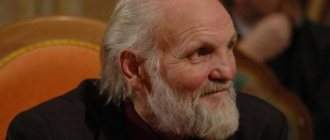| Archpriest Avvakum in an earthen prison. Old Believer hand-drawn popular print. Con. XIX century (GLM) |
Avvakum Petrovich Kondratiev
(1620-1682), defrocked archpriest of the city of Yuryevets-Povolozhsky, leader of the Old Believers, author of the famous “Life” and a number of other works. Born on November 20, 1620 [1] in the village of Grigorov near Nizhny Novgorod in the family of a priest.
In 1638 he married 14-year-old Anastasia Markovna, who became his faithful companion and mother of their eight children for the rest of her life.
In 1642 he was ordained a deacon.
According to Brockhaus, “coming from a poor family, quite well-read, with a gloomy and strict disposition, Avvakum gained fame quite early as a zealot of Orthodoxy, engaged in exorcism of demons. Strict with himself, he mercilessly pursued all lawlessness and deviation from church rules, as a result of which around 1651 he had to flee from the indignant flock to Moscow.”
In 1652 he was elevated to protopriest, that is, senior priest.
At the end of the same year he begins to serve in Moscow in the Kazan Cathedral. During these years, he took part in the circle of “zealots of piety”, or “lovers of God,” which was headed by the royal confessor Stefan Vonifatiev. The same circle included the Nizhny Novgorod Metropolitan and future Patriarch Nikon. The unity of views of Archpriest Avvakum and Nikon during this period is emphasized by the fact that Avvakum’s signature is on the petition to the Tsar with a request to appoint Nikon as Patriarch.
Habakkuk, reputed to be a scholar and personally known to the king, participated under Patriarch Joseph (+ 1652) in the “book correction.” Patriarch Nikon replaced the former Moscow inquiry officers, for whom the Greek originals were inaccessible, with Little Russian scribes led by Arseny the Greek. Nikon and his investigators introduced those “innovations” that served as the first cause of the schism. Avvakum took one of the first places among the zealots of antiquity and was one of the first victims of the persecution to which Nikon's opponents were subjected.
Already in September 1653 he was thrown into prison and they began to admonish him, but to no avail. Avvakum was exiled to Tobolsk. Only the king's intercession saved him from a more severe punishment - cutting off his hair. From 1656 to 1661 he was under the governor Afanasy Pashkov, sent to conquer the “Daurian land”, he reached Nerchinsk, Shipka and Amur, enduring not only all the hardships of a difficult campaign, but also cruel persecution from Pashkov, whom he accused of various lies. .
Meanwhile, Nikon lost all importance at court, and Avvakum was returned to Moscow (1663). The first months of his return to Moscow were a time of great personal triumph for Avvakum; the king himself showed extraordinary affection for him. Soon, however, they became convinced that Avvakum was not Nikon’s personal enemy, but an opponent of the Church. The Tsar advised him through Rodion Streshnev, if not to “unite”, then at least to remain silent. Habakkuk obeyed, but not for long. Soon he began to reproach and scold the bishops even more strongly than before, blaspheme the 4-pointed cross, the correction of the creed, the three-fingered addition, partes singing, reject the possibility of salvation according to the newly corrected liturgical books, and even sent a petition to the king, in which he asked for the deposition of Nikon and the restoration of Joseph's rites.
In 1664, Avvakum was exiled to Mezen, where he stayed for a year and a half, continuing his fanatical preaching, supporting his followers scattered throughout Russia with district messages in which he called himself “a slave and envoy of Jesus Christ,” “a proto-Singelian of the Russian church.” .
In 1666, Avvakum was brought to Moscow, where on May 13, after futile exhortations at the cathedral that met to try Nikon, he was stripped of his hair and anathematized in Uspensk. cathedral at mass, in response to which Avvakum immediately proclaimed anathema to the bishops. And after this, they did not give up the idea of convincing Avvakum, whose defrocking was met with great displeasure among the people, and in many boyar houses, and even at court, where the queen, who interceded for Avvakum, had a “great discord” with the tsar on the day of his defrocking. Habakkuk’s exhortations took place again, already in the face of the East. patriarchs in the Chudov Monastery, but Avvakum firmly stood his ground. His accomplices were executed at this time.
Avvakum was only punished with a whip and exiled to Pustozersk (1667). They didn’t even cut out his tongue, like Lazarus and Epiphanius, with whom he and Nicephorus, Archpriest of Simbirsk, were exiled to Pustozersk. Avvakum sat for 14 years on bread and water in an earthen prison in Pustozersk, tirelessly continuing his preaching, sending out letters and district messages. Finally, his daring letter to Tsar Feodor Alekseevich, in which he reviled Tsar Alexei Mikhailovich and scolded Patriarch Joachim, decided the fate of Avvakum and his three comrades. On April 14, 1682 [2] they were burned in a log house in Pustozersk.
Old Believers consider Avvakum a martyr and have icons of him. In the area of schism, Habakkuk acted not only as an example of inflexible conviction; he is also one of the most prominent teachers of schism.
43 works are attributed to Avvakum, of which 37, including his autobiography (“Life”), were published. N. Subbotin in “Materials for the history of the schism” (vols. I and V).
Avvakum’s doctrinal views boil down to the denial of Nikon’s “innovations,” which he connects with “Roman fornication,” i.e., with Latinism. In addition, Habakkuk distinguished three essences or beings in the Holy Trinity, which gave the first denouncers of the schism a reason to talk about a special sect of “Habakkukism.” However, Habakkuk's views on St. The Trinity was not accepted by the schismatics in the main mass.
Personal life
The name of the famous Old Believer is associated with two women - Feodosia Morozova, known to contemporaries as the noblewoman Morozova, and his wife Nastasya Markovna.
The first is a spiritual student of Archpriest Avvakum, like him, who suffered for her faith and inflexibility. She - frantic, with eyes burning with fire - was portrayed by Vasily Surikov. Like her spiritual mentor, Morozova died, not wanting to change her beliefs.
Boyarina Morozova
The second is a faithful wife who bore her husband nine children. The couple maintained the purity of their marriage throughout their lives. Like Avvakum, Nastasya professed the Old Believers. They got married young by today's standards: the husband turned 17, the wife 14 years old. They come from the same village, both from impoverished families, half orphans.
The couple lived as prescribed by Domostroy: the future preacher married a girl at the direction of his mother. But the marriage was sanctified by love: the wife resignedly followed her husband into exile and wanderings. In Siberia, on the way to the place of exile in Tobolsk, two young sons died, unable to withstand the harsh conditions.
Boyarina Morozova visits Avvakum in prison
Avvakum Petrovich saw in his wife the ideal of an Orthodox woman and called Nastasya “an assistant to salvation.” Nastasya Markovna became an example for the wives of the Decembrists, convicts and all exiles, for women who renounced a calm and comfortable life and followed their husbands.
In the book “Punishment without Crime,” Alexander Avdeenko recalled a story that came down to his contemporaries and characterizes the couple’s relationship. Exhausted by yet another exile, Nastasya asked her husband how long she would suffer, to which the priest replied:
- Markovna! Until my death. “Okay, Petrovich, otherwise we’ll wander on.”
The woman’s answer became a kind of motto for all wives who shared the plight of their husbands. Anastasia Markovna died before her husband. The husband experienced the death of his significant other hard: his main support, adviser and friend left.
Interesting Facts
- Avvakum is called the founder of free speech, confessional prose and figurative literature. 43 works are attributed to him, including “The Book of Conversations”, “The Book of Reproofs”, and “The Book of Interpretations”. The most famous work is “Life”, the translation of books of which is still popular today.
- Archpriest Avvakum is the hero of the 20-episode film by Nikolai Dostal “Raskol”. The main theme of the series is the reforms carried out by Patriarch Nikon and the resistance led by Archpriest Avvakum.
- The Old Believer is called the first preacher of mass suicide in world religious teachings. During the peak years of his popularity, the number of mass self-immolations increased. At the beginning of 1687, more than 2,000 people were burned in the Paleostrovsky monastery. On August 9 of the same year in Berezovo, Olonetsky district - more than 1000.
Archpriest Avvakum on Orthodox and Old Believer icons
- The Old Believer icons that Avvakum worshiped are distinguished by the abundance of inscriptions on the margins and dark faces. In the 18th century, official Orthodoxy banned the production of such icons.
- Habakkuk's texts contained statements that are called "prophetic." During the years of the revolution and civil war, a quote from Avvakum sounded special: “Satan begged God for a bright Russia, may he stain it with the blood of martyrdom.”
- M. Prishvin, in his lectures at the “people's university,” interpreted Grigory Rasputin as “an instrument of Archpriest Avvakum’s revenge” on the Romanov dynasty.
At the beginning of the 20th century, the Old Believer Church canonized him as a saint, and in the village of Grigorovo at the end of the 20th century a monument to Avvakum was erected.
Death
After the death of Tsar Alexei Mikhailovich, the throne was taken by his son Fyodor Alekseevich, pious and impressionable. The rebellious Habakkuk, hoping that he would be able to turn the monarch away from the hated Greek rite, wrote him a letter. He said that he had a dream about Father Alexei Mikhailovich burning in hellfire for accepting the Nikonian teaching.
The archpriest did not calculate that Fyodor would become angry and accuse him of “the great blasphemy against the royal house” and church schism. The king's contemporary was severely punished. In 1682, the Old Believer and his associates Epiphanius, Lazarus and Fedor were executed in front of the crowd. They were tied to the corners of the log house, covered with birch bark and dry branches and set on fire.
Burning of Archpriest Avvakum
Archpriest Avvakum knew about the impending execution, distributed books and meager property, and put on a white shirt. It is noteworthy that he considered fire to be cleansing and repeatedly called for self-immolation. He himself died from the fire.
The execution took place on Friday of Holy Week. According to the information received, when the flame shot up into the sky, Avvakum raised his hand with two fingers and exclaimed:
“Orthodox! If you pray with such a cross, you will never perish. If you leave this cross, your city will be covered with sand, and then the world will end!”
Childhood and youth
Avvakum Petrovich Petrov was born in the village of Grigorovo, Nizhny Novgorod district in 1620. My mother was an example for the future preacher and spiritual mentor of the Old Believers. Mary (later she became a nun and received the name Martha) raised Habakkuk in severity and spiritual purity. Adhering to the old Orthodox canons, spending her free time in prayer and fasting, the woman raised her son in the “fear of God.”
Monument to Archpriest Avvakum
The father, a hereditary parish priest, died when his son was 15 years old. According to Avvakum, his father loved to drink, which was the reason for his early death.
At the age of 22, Avvakum Petrov was ordained a deacon for his zeal in faith and strict adherence to the Law of God.



